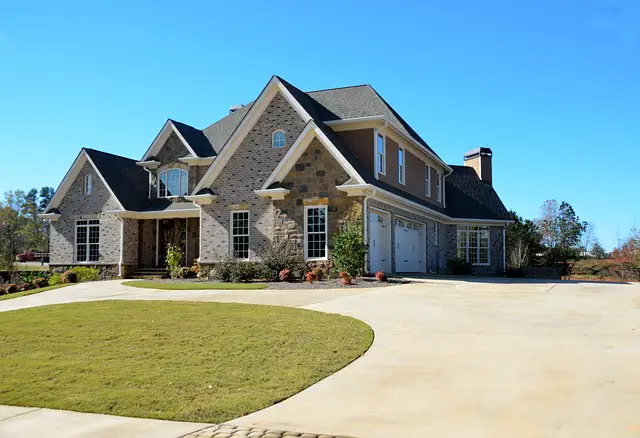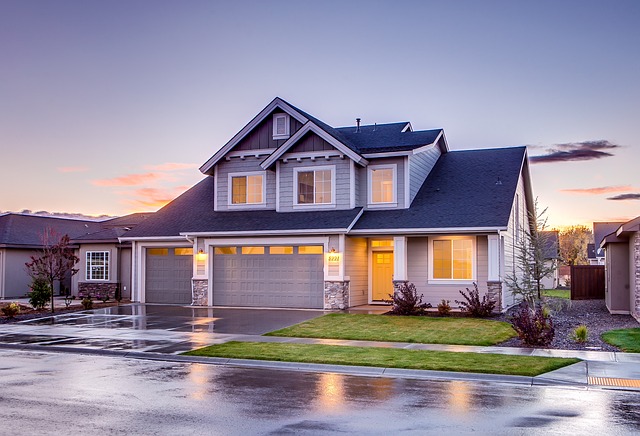Residential pertains to properties used for living, like houses or apartments. Commercial relates to properties used for business or profit-making, such as offices, stores, or warehouses.
Understanding Residential Properties

Residential properties are properties specifically designed and built for dwelling purposes. They typically include houses, apartments, condominiums, townhouses, and other similar structures. These properties provide spaces for individuals and families to live and cater to their residential needs.
Definition and Characteristics of Residential Properties
Residential properties, as their name suggests, are properties primarily used for housing purposes. They are specifically designed to serve as a place where individuals or families can live and engage in their daily activities. The defining elements of residential properties encompass the presence of bedrooms, bathrooms, kitchens, living spaces, and other essentials that ensure a comfortable living experience.
A significant characteristic of residential properties is their usual location in residential areas or neighborhoods. These areas typically comprise a blend of single-family homes, townhouses, or apartment buildings, thereby fostering a strong sense of community. Moreover, residing in such areas grants easy access to essential amenities like schools, parks, and shopping centers.
Another vital aspect of residential properties is that they are either owned or rented by individuals or families for an extended duration. This ownership provides a sense of stability and the opportunity to accumulate equity over time. Conversely, renting a residential property offers flexibility and facilitates easy relocation if necessary.
In addition, residential properties offer individuals privacy and a space where they can unwind and rejuvenate. These properties are meticulously designed to prioritize comfort and create a cozy atmosphere reminiscent of a home. Additionally, depending on the type of property, they may also offer various amenities such as swimming pools, fitness centers, or playgrounds.
Types of Residential Properties
The types of residential properties, including single-family homes, apartments, condominiums, townhouses, and cooperative housing, offer different options for individuals and families.
- Single-family homes: These detached houses cater to the needs of a single family. They provide ample privacy and space, distinguishing themselves from other types of residential properties.
- Apartments: Residential units within larger buildings or complexes fall into this category. Apartments are typically rented out and offer various amenities like shared facilities such as a gym or pool, along with maintenance services.
- Condominiums: Also known as condos, these properties resemble apartments. However, each unit is individually owned, while residents share common areas and amenities.
- Townhouses: These multi-story homes are characterized by their narrow structures and shared walls with adjacent properties. Townhouses provide an urban living experience and often include shared amenities.
- Cooperative housing: This type of housing involves residents owning shares in a corporation that owns the entire property. Each resident has the right to occupy a specific unit and actively participates in decision-making processes.
When selecting a residential property, it’s essential to take into account factors such as lifestyle needs, budget, preferred location, and long-term goals.
Ownership and Usage of Residential Properties
Ownership and usage of residential properties can vary depending on individual preferences and circumstances. It is important to consider these key aspects:
- Ownership: The ownership of residential properties can be obtained through either outright purchase or renting. Homeownership offers the advantages of long-term stability and the potential for property value appreciation. On the other hand, renting provides flexibility and freedom from responsibilities such as maintenance and property taxes.
- Usage: Residential properties are primarily utilized as homes for individuals or families. They offer a private and comfortable living space, complete with amenities such as bedrooms, bathrooms, kitchens, and living areas. Residential properties can fulfill various purposes, including serving as primary residences, vacation homes, or investment properties.
- Residential Communities: Many residential properties are situated within communities or housing complexes. These communities may provide additional amenities like parks, swimming pools, gyms, and security services. They also offer opportunities for social interaction and a sense of belonging.
- Regulations: Residential properties are subject to zoning regulations and local laws. These regulations dictate the allowable use of the property, such as whether it can be utilized for commercial purposes or rented out. Homeowners’ associations may impose specific rules and restrictions that homeowners must adhere to.
- Responsibilities: When owning a residential property, certain responsibilities come with it, including property maintenance, repairs, and the payment of property taxes. Homeowners may also be required to follow community guidelines and contribute to shared expenses for common facilities.
Taking these factors into consideration can assist individuals in making informed decisions regarding the ownership and usage of residential properties based on their specific needs and circumstances.
Exploring Commercial Properties

Commercial properties are properties primarily used for business and commercial activities. They are designed to accommodate various commercial ventures, enterprises, and organizations. Commercial properties can include office buildings, retail stores, industrial warehouses, hotels, and restaurants.
Definition and Characteristics of Commercial Properties
Commercial properties, also known as business or profit-making properties, are buildings or land specifically used for commercial purposes. They possess unique features that set them apart from residential properties. The definition and characteristics of commercial properties play a major role in understanding investment opportunities in the commercial real estate market.
Firstly, ownership of commercial properties primarily lies with businesses or investors rather than individual owners. Corporations, partnerships, and individual investors often own these properties. Consequently, the ownership structure differs significantly from that of residential properties.
Secondly, commercial properties are utilized for business, commerce, or trade-related activities. This includes a wide range of establishments such as office buildings, retail stores, warehouses, industrial facilities, hotels, and restaurants. The purpose of these properties revolves around facilitating commercial operations.
Moreover, commercial properties generally have greater sizes in comparison to residential properties. Their spacious design caters to the needs and demands of businesses in terms of accommodating various operations and functions.
Furthermore, commercial properties are subject to zoning regulations which specify the acceptable uses of the property within a particular area. These zoning laws advocate for an appropriate distribution of commercial properties to maintain a balance between residential and commercial regions.
Income generation is a key aspect associated with commercial properties. These properties are specifically designed to generate income through rent or lease payments. Businesses or individuals often rent these spaces for their operational needs, ensuring a steady flow of income.
Considering commercial properties for investment requires careful evaluation of crucial factors including location, accessibility, market demand, and potential rental income. While they offer higher returns compared to residential properties, investing in commercial properties also entails higher risks. Engaging the expertise of real estate professionals can greatly assist in making well-informed decisions.
Thus, comprehending the definition and characteristics of commercial properties is vital when exploring investment opportunities within the commercial real estate market.
Types of Commercial Properties
- Retail properties are commercial properties that are used for selling goods or services directly to consumers. They can include shopping malls, department stores, retail stores, and specialty shops.
- Office buildings are commercial properties designed to provide space for businesses to conduct their operations. They can include office towers, business parks, and co-working spaces.
- Industrial properties are commercial properties used for industrial purposes such as manufacturing, warehousing, and distribution. They can include factories, warehouses, industrial parks, and logistics centers.
- Hospitality properties are commercial properties used for lodging and providing accommodations to travelers. They can include hotels, motels, resorts, and bed and breakfast establishments.
- Medical facilities are properties specifically designed for healthcare services and can include hospitals, clinics, medical offices, and specialized healthcare facilities.
- Entertainment venues are commercial properties used for hosting events, performances, and other forms of entertainment. They can include theaters, arenas, concert halls, and sports stadiums.
- Restaurants and food establishments are properties used for dining and food services. They can include restaurants, cafes, food courts, and fast-food chains.
- Mixed-use properties combine different uses, such as residential units with retail and office spaces. They can include mixed-use developments, town centers, and live-work spaces.
Usage and Purpose of Commercial Properties
Commercial properties serve various purposes and are utilized for different activities. The usage and purpose of commercial properties are diverse and cater to different industries and sectors.
1. Office Spaces: Commercial properties are often used as office spaces for businesses and organizations. These spaces provide a professional environment for employees to work and conduct business operations. The usage and purpose of commercial properties in this context are to serve as productive workspaces.
2. Retail Stores: Commercial properties serve as retail spaces for businesses to display and sell their products or services. These properties can be in the form of standalone shops, shopping malls, or department stores. The usage and purpose of commercial properties in this context are to provide convenient and attractive spaces for retail businesses.
3. Restaurants and Cafes: Commercial properties are also used as establishments to serve food and beverages. These spaces are designed to accommodate customers and provide dining experiences. The usage and purpose of commercial properties in this context are to create enjoyable and comfortable dining environments.
4. Warehouses and Industrial Spaces: Commercial properties are utilized for storage and large-scale industrial activities. These spaces are ideal for manufacturing, distribution, and logistics operations. The usage and purpose of commercial properties in this context are to facilitate efficient storage and industrial processes.
5. Entertainment and Leisure Facilities: Commercial properties are transformed into entertainment venues such as theaters, cinemas, concert halls, and amusement parks. These spaces are designed to host various events and provide recreational experiences. The usage and purpose of commercial properties in this context are to offer entertainment and leisure opportunities for people.
6. Hotels and Hospitality: Commercial properties are used for accommodations in the form of hotels, resorts, and guest houses. These spaces offer lodging facilities and services to travelers and tourists. The usage and purpose of commercial properties in this context are to provide comfortable and convenient accommodations for guests.
7. Educational Institutions: Commercial properties can be repurposed as schools, colleges, or training centers. These spaces provide environments conducive to learning and education. The usage and purpose of commercial properties in this context are to facilitate educational activities and programs.
The purpose and usage of commercial properties are diverse and cater to different industries and sectors. The type of commercial property chosen depends on the specific needs and goals of the business or organization.
Key Differences Between Residential and Commercial Properties
Purpose and Function
Residential properties
- Serve the primary function of providing a comfortable and secure living environment for individuals and families.
- Examples include houses, apartments, condominiums, and townhouses.
- Main function is to provide spaces for individuals and families to live, sleep, bathe, cook, and socialize.
- Typically have bedrooms, bathrooms, kitchens, and living areas for residents’ needs.
- Usually located in residential neighborhoods or communities, away from busy commercial areas.
- Typically owned by individuals or families for primary residences or as investment properties for rental income.
Provide a sense of privacy, personal space, and a place to retreat and relax.
Commercial Properties
- Designed and used primarily for business or profit-making activities.
- Examples include office buildings, retail stores, warehouses, and industrial facilities.
- Main purpose is to provide spaces for businesses to operate, sell products or services, and generate profits.
- Often have different sections or areas designated for specific business activities, such as offices, sales areas, storage areas, and production areas.
- Often situated in commercial districts or areas with high foot traffic and accessibility to target markets.
- Owned by individuals, corporations, or companies who lease or rent these spaces to other businesses for various purposes.
- Offer opportunities for entrepreneurship, business growth, and economic activities contributing to local economic development.
Understanding the purpose and function of residential and commercial properties is essential when considering whether to invest or live in them.
Ownership and Investment
When considering ownership and investment in residential and commercial properties, there are several key factors to take into account:
- Profit potential: Commercial properties generally have higher potential for income generation through rental or lease agreements, as they are often used for business purposes. Residential properties, on the other hand, can provide a steady source of income through rental payments.
- Market conditions: The demand for residential properties tends to be more stable compared to commercial properties, which can be influenced by economic fluctuations and changes in the business landscape. It’s important to research and understand the current market conditions before making an investment decision.
- Long-term appreciation: While the value of residential properties generally appreciates over time, commercial properties may have higher potential for capital appreciation. Factors such as location, market trends, and the economic development of the area can greatly influence the long-term value of the property.
- Ownership costs: Both residential and commercial properties come with their own set of ownership costs, such as property taxes, maintenance expenses, insurance, and utilities. It’s important to consider these costs when evaluating the investment potential of each property type.
- Risk tolerance: Commercial properties often come with higher risks due to tenant turnover, market fluctuations, and potential vacancy periods. Residential properties typically have a lower level of risk, particularly if the rental market is stable. Consider your risk tolerance and financial goals before deciding which type of property to invest in.
The decision between investing in residential or commercial properties ultimately depends on factors such as profit potential, market conditions, long-term appreciation, ownership costs, and risk tolerance. It’s important to carefully evaluate these factors and conduct thorough research before making an informed investment decision.
Zoning and Regulations
Zoning and regulations are instrumental in determining the utilization and growth of residential and commercial properties. When contemplating the acquisition or investment in a property, it is vital to comprehend these factors.
- Zoning: Zoning laws segregate land into distinct zones, such as residential, commercial, or industrial, to provide guidance for the usage and development of properties within each zone. The primary objective of zoning is to ensure the compatibility of land utilization and safeguard the well-being, safety, and welfare of inhabitants and businesses.
- Regulations: Regulations establish specific rules and prerequisites that must be followed when using or developing a property. These regulations encompass various aspects, including building codes, setback requirements, parking regulations, and signage restrictions. Compliance with these regulations is imperative to obtain the necessary permits and approvals for construction or operation.
- Residential Zoning Restrictions: Residential zoning generally constrains property usage to single-family homes, multi-family buildings, or mixed-use developments. Additionally, it may impose limitations on building height, lot size, and density to preserve the character and quality of residential neighborhoods.
- Commercial Zoning Restrictions: Commercial zoning permits diversified types of businesses, such as retail stores, offices, restaurants, and hotels. Different commercial zones might entail specific regulations concerning building size, parking requirements, and noise levels to ensure compatibility with the surrounding areas.
- Variances and Special Permits: In certain circumstances, property owners or developers may seek variances or special permits to deviate from zoning or regulatory provisions. However, these requests must substantiate unique conditions and present evidence showing that the proposed use or development will not adversely affect the surrounding area.
- Importance of Compliance: Strict adherence to zoning and regulatory requirements is fundamental to avoid legal problems and penalties. Non-compliance can lead to fines, compelled closure of businesses, or even legal action from affected neighbors or the municipality.
Property Value and Rental Income
When considering property value and rental income, there are several factors to take into account:
1. Location: The location of a property plays a significant role in determining its value and rental income potential. Properties in desirable neighborhoods or areas with high demand tend to have higher values and rental rates.
2. Condition and Amenities: The condition of the property and the amenities it offers can also impact its value and rental income. Well-maintained properties with modern amenities such as updated kitchens, bathrooms, or in-unit laundry facilities are likely to attract higher-paying tenants.
3. Market Conditions: The state of the real estate market, including supply and demand dynamics, can influence property values and rental income. In a seller’s market with high demand and limited supply, property values may increase, leading to higher rental rates.
4. Comparable Properties: Examining the rental rates and property values of similar properties in the area can provide insights into the potential rental income and value of a specific property. Comparing properties with similar characteristics, such as size, location, and amenities, can help estimate the potential rental income.
5. Rental Market Trends: Staying informed about rental market trends, such as vacancy rates and rental price fluctuations, can help gauge the potential rental income of a property. Researching the demand for rentals in the area and whether rental rates are projected to increase or decrease can inform investment decisions.
Factors to Consider When Choosing Between Residential and Commercial Properties
When it comes to choosing between residential and commercial properties, there are several factors to take into consideration. In this section, we will explore the key aspects that can influence your decision-making process. From personal needs and lifestyle preferences to investment goals and financial considerations, we will delve into the essential factors that should guide your choice. We will look at market trends and demand to provide you with a comprehensive understanding of the real estate landscape. Remember, making an informed decision is crucial in finding the perfect property for your unique situation.
Personal Needs and Lifestyle
When choosing between residential and commercial properties, it’s important to consider your personal needs and lifestyle. Here are some factors to think about:
- Space requirements: Determine how much space you need for yourself or your family. Residential properties generally offer more living space, while commercial properties are designed for business operations.
- Location preferences: Consider the location that best suits your lifestyle. Residential properties are often found in residential neighborhoods with amenities like schools, parks, and shopping centers. Commercial properties are typically located in commercial or industrial areas.
- Proximity to amenities: Think about the amenities you value. Residential properties are more likely to be located near residential amenities such as supermarkets, gyms, and restaurants. Commercial properties may be near business services, transportation hubs, or retail centers.
- Lifestyle requirements: Evaluate your lifestyle needs. Residential properties offer privacy and the ability to customize living spaces. Commercial properties provide opportunities for business growth and networking.
- Future plans: Consider your long-term plans and goals. If you’re looking to start a business or invest in rental properties, commercial properties may be more suitable. If you prioritize stability and a place to call home, residential properties may be the better choice.
Pro-tip: Before making a decision, take the time to thoroughly assess your personal needs and lifestyle. Consider your current situation as well as your future goals to ensure that the type of property you choose aligns with your long-term plans.
Investment Goals and Financial Considerations
- Return on Investment: When considering investment goals and financial considerations, it is important to evaluate the potential return on investment for both residential and commercial properties. Residential properties generally offer long-term appreciation and rental income, while commercial properties may provide higher rental yields and the opportunity for increased capital gains.
- Financial Stability: Assess your financial situation and determine if you have the resources to invest in either residential or commercial properties. Take into account factors such as down payment requirements, mortgage rates, and maintenance costs when considering investment goals and financial considerations.
- Risk Tolerance: It is essential to evaluate your risk tolerance and consider the level of risk associated with residential and commercial properties in terms of investment goals and financial considerations. Residential properties are generally considered lower risk, while commercial properties may involve higher risks due to factors such as market fluctuations and tenant vacancies.
- Market Analysis: As part of investment goals and financial considerations, conduct thorough market research and analyze the current trends and demand for both residential and commercial properties. Consider factors such as supply and demand dynamics, rental market stability, and economic growth projections when conducting market analysis.
- Diversification: To achieve investment goals and financial considerations, evaluate your investment portfolio and consider the benefits of diversifying your investments. Investing in both residential and commercial properties can provide a balanced portfolio and reduce risk.
Pro-tip: Consult with a real estate professional or financial advisor to help you evaluate your investment goals and financial considerations. They can provide invaluable insights and help you make an informed decision.
Market Trends and Demand
Market trends and demand play a vital role in the real estate industry as they determine the desirability and profitability of both residential and commercial properties. It is crucial for investors to understand these factors so that they can make well-informed decisions about their real estate investments.
To highlight the significance of market trends and demand, let’s delve into a true anecdote. In a bustling city, a developer made the decision to construct a residential building in an emerging neighborhood. At that time, the area was experiencing substantial growth, with new businesses and amenities sprouting up nearby. The demand for housing in the vicinity was exceptionally high due to its convenient location and potential for further development. As a result, the developer’s investment in the residential property proved to be a remarkable success, with high occupancy rates and lucrative rental income.
Conversely, another developer opted to invest in a commercial property situated in a declining neighborhood. Unfortunately, market trends indicated a decreasing demand for commercial spaces in the area due to businesses relocating to more vibrant parts of the city. Consequently, the commercial property struggled to attract tenants, resulting in vacancies and a decline in rental income.
This story clearly demonstrates the significant impact that market trends and demand can have on the success of real estate investments. It is imperative for investors to conduct thorough research and analysis of current market conditions, including aspects such as population growth, employment rates, and industry developments, in order to gauge the demand for both residential and commercial properties in a particular area. By staying well-informed about market trends and demand, investors can make sound decisions and maximize their returns on investment.
Frequently Asked Questions
What is the difference between residential and commercial real estate?
Residential real estate refers to single-family homes, townhomes, condos, mobile homes, and multiplex buildings. Commercial real estate, on the other hand, includes apartment complexes, industrial spaces, hotels, retail spaces, and office spaces. The key distinction lies in the intended use of the property and the number of residential units.
What are the main advantages of investing in residential properties?
Residential properties offer a lower cost of entry, making it more accessible for beginners in real estate investing. Additionally, rental residences tend to have longer lease terms and decreased tenant turnover, providing more stability. The laws governing residential property are also typically less complex, making it easier to navigate for investors.
What advantages does commercial real estate investment offer?
Investing in commercial properties, especially those located in prime areas, can provide a higher return on investment (ROI) due to the earning potential from businesses willing to pay a premium for a strategic location. Commercial properties also often come with qualified tenants who respect the property and provide excellent customer service.
What are the differences in lease terms between residential and commercial real estate?
Residential properties usually have shorter lease terms, typically around one year. In contrast, commercial real estate leases are longer, ranging from three to twenty years. The longer lease terms in commercial properties ensure a steady cash flow and provide greater stability for investors.
What are the financial responsibilities of tenants in residential and commercial leases?
In residential leases, tenants are generally responsible for paying their rent and utility costs. On the other hand, commercial leases often involve triple net leases (NNN), where tenants pay for recurring expenses such as insurance, utilities, and taxes. This reduces the owner’s maintenance costs and increases the cash flow for commercial property owners.
How do residential and commercial properties differ in terms of risk and complexity?
Investing in residential properties carries lower risk and complexity compared to commercial real estate. Residential properties are more suitable for beginners due to their lower cost of entry and less complicated legal requirements. Commercial investments, while potentially providing higher ROI, require more research, larger capital, and a deeper understanding of market dynamics.
Image Credits
Featured Image By – Pexels from Pixabay
Image 1 By – Paul Brennan from Pixabay
Image 2 By – F. Muhammad from Pixabay







